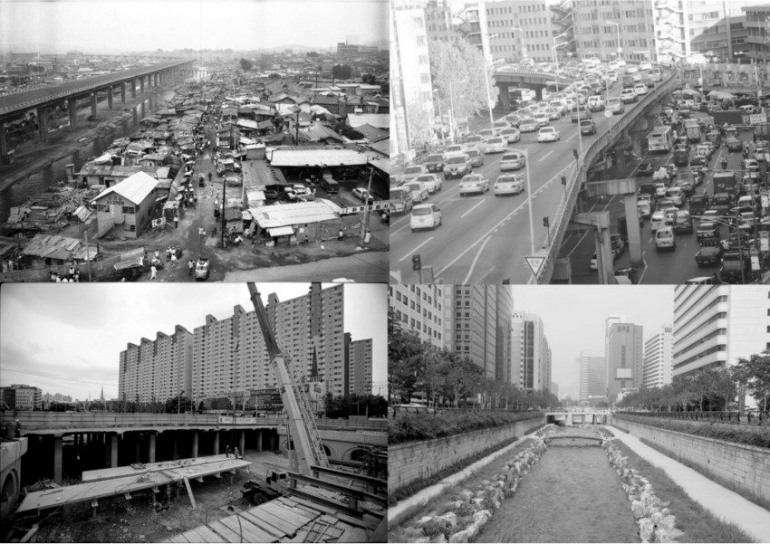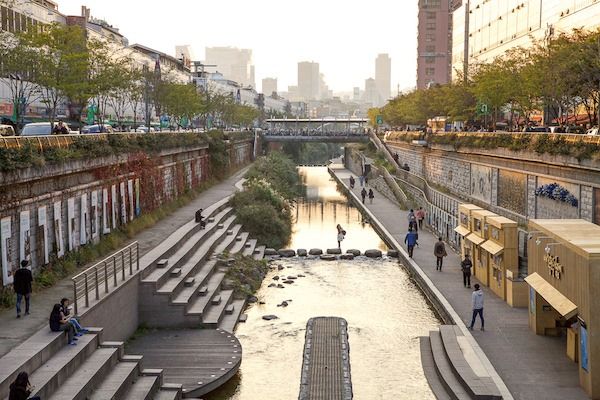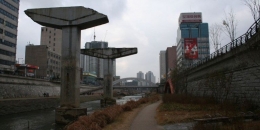From a slum river to a green and environmentally friendly river. At first glance, maybe no one would have thought that this beautiful and shady river area has a lot of history as well as interesting facts that brought about major changes in urban planning in South Korea. Cheonggyecheon [청계천] or commonly known as Cheonggyecheon Stream, a river that stretches almost 11 km in the city of Seoul is one example of South Korea's success in improving the quality of life and environmental quality by returning the river back to its original function.
From a former flyover into a green belt area that combines four zones: history, urban, cultural, and nature. Cheonggyecheon is the beginning of the movement to revitalize the wider of Seoul City, which has benefited from eliminating the gap between the southern and northern regions of the river. The success of the Cheonggyecheon Stream restoration has had a worldwide effect. This project has become a reference for many cities and countries regarding the use of existing assets with due regard to ecology, environmental quality and urban sustainability.
Cheonggyecheon gives an answer to the controversial debate in urban planning among those who emphasize vehicle-oriented cities and those who believed cities should be more pedestrian-friendly.
Already Exists Since Joseon's Era
![[Cheonggyecheon Stream at Joseon's Era]/Koreabridge.net](https://assets.kompasiana.com/items/album/2021/03/10/gambar-1-60488de68ede483abe118ac2.jpg?t=o&v=770)
The 11 km long flowing river was originally named Gaecheon (meaning open flow) after the first restoration project to build a drainage system in the Joseon Dynasty. The project also focused on dredging and strengthening river banks and building bridges, and was carried out every 2-3 years since the reign of King Taejong, the third king of the Joseon Dynasty. Then during the reign of King Yeonjo, the restoration work was carried out specifically as a national project. The name Gaecheon was renamed Cheonggyecheon (until now) when Korea was under Japanese rule. During this period, financial distress became an obstacle for The Japanese Imperial troops to cover the river flow, despite various attempts.
![[Cheonggyecheon Stream when Occupied by Immigrants]/Koreabridge.net](https://assets.kompasiana.com/items/album/2021/03/10/gambar-2-60488e45d541df6a6166cdf3.jpg?t=o&v=770)
A Picture of Past Poverty in South Korea
The Cheonggyecheon Stream is a residential area for immigrants who want to try their luck in the capital city. After the Korean War (1950 - 1953), many immigrants who migrated to Seoul to earned money and stayed along the river in shabby temporary houses, even the river flow was used by residents as landfills, this made the river polluted and gave off an unpleasant odor. This condition is exacerbated by the large amount of garbage, sand, and waste along the river that spoils the city view making the face of Seoul City even worse.
From Rivers to Flyover
![[Cheonggyecheon Flyover]//Preservation Institute/](https://assets.kompasiana.com/items/album/2021/03/10/gambar-3-60488f298ede48777a4bb332.jpg?t=o&v=770)
At this time, Seoul began to enter a period of industrialization and modernization where the Cheonggyecheon Freeway was used as a symbol of the success of this development. However, in the late 1980s, congested roads were seen as the cause of poor air quality and environmental degradation. Furthermore, Cheonggyecheon stated as the city's fault line separating the dynamic southern area of the road from the lagging and less competitive northern area. Moreover, the Cheonggyecheon Freeway often jammed, the supporting poles began to be damaged and eroded, as a result the maintenance was very expensive for 30 years.
The River Which Has Beginning to Restored Again
![[Revitalization of Cheonggyecheon Stream]/Koreabridge.net](https://assets.kompasiana.com/items/album/2021/03/10/gambar-4-60488f55d541df19a17170f4.jpg?t=o&v=770)
The revitalization began with cleaning the river water and building pumping stations to drain water from the Han River because the water in the Cheonggyecheon Stream was almost dry. Then created public spaces and green open spaces in the form of a linear garden with a land area of 400 hectares. Continued construction of a pedestrian road connecting the two sides of the river was built. There are 22 bridges built over the river, 7 of which are specifically for pedestrians. This revitalization takes approximately 2 years.
Green Open Space Area
![[The New Beginning of Cheonggyecheon Stream]/development.asia](https://assets.kompasiana.com/items/album/2021/03/10/gambar-5-60488fed8ede48293e5960b2.jpg?t=o&v=770)
This is very important for climate adaptation, as well as increasing flood resistance when cities have open waterways. Not only that, the population of natural ecology also increases, such as birds, fish, insects and plants. Based on a 2009 report, the number of bird species in the river corridor increased from 6 to 36, fish species from 4 to 25, and insect species from 15 to 192. The river area has a green corridor which is 8 km long and 730 meters wide, with a 400 hectare garden, waterfalls, bridges, and running tracks.
The Remaining Pillars on The Other Side of Cheonggyecheon Stream

From Nothing to Extraordinary Cheonggyecheon Stream

Finally, a Beautiful Cheonggyecheon Stream :)

Articles and Photos Reference:
Arsitek Kemarin Sore, (Article)
Medcom.id, (Article)







![[Source: kr.trip.com]](https://assets.kompasiana.com/items/album/2021/03/10/gambar-9-60489306d541df559417d493.jpg?t=o&v=770)
![[Source: kr.trip.com]](https://assets.kompasiana.com/items/album/2021/03/10/gambar-9-60489306d541df559417d493.jpg?t=o&v=260)
![[Cheonggyecheon Stream at Joseon's Era]/Koreabridge.net](https://assets.kompasiana.com/items/album/2021/03/10/gambar-1-60488de68ede483abe118ac2.jpg?t=o&v=260)
![[Cheonggyecheon Stream when Occupied by Immigrants]/Koreabridge.net](https://assets.kompasiana.com/items/album/2021/03/10/gambar-2-60488e45d541df6a6166cdf3.jpg?t=o&v=260)
![[Cheonggyecheon Flyover]//Preservation Institute/](https://assets.kompasiana.com/items/album/2021/03/10/gambar-3-60488f298ede48777a4bb332.jpg?t=o&v=260)
![[Revitalization of Cheonggyecheon Stream]/Koreabridge.net](https://assets.kompasiana.com/items/album/2021/03/10/gambar-4-60488f55d541df19a17170f4.jpg?t=o&v=260)
![[The New Beginning of Cheonggyecheon Stream]/development.asia](https://assets.kompasiana.com/items/album/2021/03/10/gambar-5-60488fed8ede48293e5960b2.jpg?t=o&v=260)




